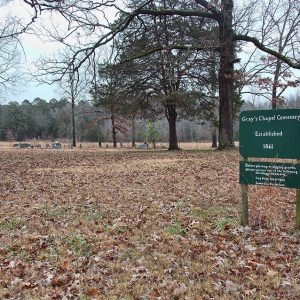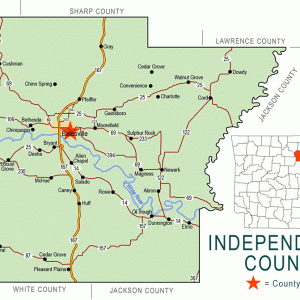calsfoundation@cals.org
Gray (Independence County)
Gray is a historical community in Barren Township that is somewhat an offshoot of Hickory Valley (Independence County). All that is left of the community today is Gray’s Chapel Cemetery located north of Sandtown Road on Arrowhead Lane between Highway 167 (North St. Louis Street) and Cold Creek Lane. Barnett Creek and Barnett Cemetery are close by, as is Basket Creek.
The first white settlers in the area were members of the Barnett family of North Carolina. John Barnett and his two sons—Elijah Barnett and a brother who went by A. Barnett—were living in the Arkansas Territory by the early 1820s. The area was first known as Jefferson after President Thomas Jefferson, who had made the Louisiana Purchase possible. By 1860, the name Barren Township was being used to designate where the Gray family had begun the establishment of Gray’s Chapel and the Hickory Valley Church. John Barnett and his sons, along with other members of the family, are interred in the Barnett Cemetery; the oldest family stone to have been located is that of A. Barnett, showing his death date of 1846 (at age twenty-two).
The Gray family had moved west from North Carolina during the decade before the Civil War, mainly to promote the Methodist Protestant religion in the hills of Arkansas. The Reverend Andrew (Andy) Gray and his nephew, the Reverend James Burrow Hines (Burr) Gray, were instrumental in founding two churches near Horn Cave, later called Crystal Spring Cave in what became Cave City (Sharp and Independence counties). Rev. Burr Gray helped found and establish Hickory Valley Church; the old building on Highway 167, in a state of disrepair, burned in June 2016. Rev. Andy Gray helped found and establish Gray’s Chapel two miles northwest of Hickory Valley Church. The original log chapel was built around 1861. The log church was replaced in 1889 by a square clapboard meeting-house structure typical of early Methodist churches in Arkansas. The new chapel had separate entrance doors for men and women; men sat on the right and women sat on the left.
By 1849, a large range of manganese ore deposits had been discovered in northwestern Independence County with a spillover into Sharp, Izard, and Stone counties. This discovery came to be labeled the Batesville District, with Cushman (Independence County) at its center, and contained the community of Gray. The E. W. Roach, Milligan, and Eliza Patterson prospects are within a two-mile radius of Gray’s Chapel Cemetery. (A prospect is a manganese ore “dig.”)
Elisha Columbus Gray, a half-brother to Rev. Burr Gray, was instrumental in setting up the Gray Institute near his father’s home. The institute, also known as Fairfield Academy—where Elisha Gray taught mathematics, Greek, and Latin—opened in about 1854. The institute stayed active until the 1890s. Pine Springs School was built following the closing of Gray’s Institute and was still active in 1936. In the 1940s, Pine Springs School merged with the Cave City School District.
The cause of the decline of Gray is unclear but may be connected with the appearance of the new town of Cave City, which ended up in Sharp County when a three-mile strip of Independence County was transferred to Sharp County in 1879. As Cave City grew, Gray and Hickory Valley became smaller, until all that is left in the twenty-first century bearing the Gray name is the small Gray’s Chapel Cemetery.
Gray’s Chapel closed in 1960; the abandoned building burned in 1997. Just before the burning, the Reverend Jim Beal had acquired the historic church bell and a handmade pulpit from the church to display in the Arkansas United Methodist Museum in Little Rock (Pulaski County). According to Mary Kay Woodyard, a descendant of Rev. Andy Gray, the bell had hung on a post near the back door of Gray’s Chapel and had been used throughout the church’s existence. Rev. Gray died on May 16, 1897, and is buried in Gray’s Chapel Cemetery.
For additional information:
Britton, Nancy, with Mary Kay Woodyard. “William Andrew Gray and the Gray’s Chapel Methodist Protestant Church.” Independence County Chronicle 39 (October 1997–January 1998): 3–16.
A History of Cave City, Arkansas. Mt. Vernon, IN: Windmill Publications, 2001.
“Legible Tombstones in Gray’s Chapel Cemetery.” Independence County Chronicle 39 (October 1997–January 1998): 17–20.
McGinnis, A. C. “A History of Independence County, Ark.” Special issue. Independence County Chronicle 17 (April 1976).
Kenneth Rorie
Van Buren, Arkansas
 Gray's Chapel Cemetery
Gray's Chapel Cemetery  Independence County Map
Independence County Map 




Comments
No comments on this entry yet.